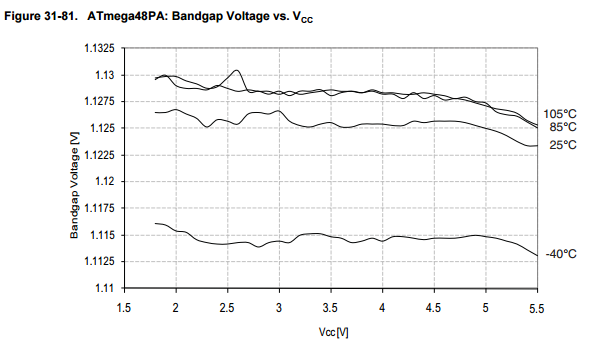reporting battery to domoticZ
-
Hi im using at this moment what i had.
270k-100k giving me 1.07 volt at 4.2 batterySo i stay save , but ok reading is not giving my wanted 4.2 volt but around 3.92 volt
My nano is feeded by an dc -dc boost converter giving me 5 volt from this 4.2 battery.
@AWI
Sorry im still a noob in this, just understood how to make a voltage diver using 3:1 divider
.
Could you please give me a simple example how do this calculation.@Rene046 You making it complex. The steps)
- Make sure that the input voltage is within the range of the reference. You did that with the voltage divider (max 1.07 V) :+1:
- set
vRefin the sketch to an expected value (4.2 / 1 , where 1 is the calibration value). You did (4.2/1.07) :+1: - Now you need to calibrate in the software:
- Measure the battery voltage (batteryVoltage) (not the voltage divider) with the multimeter. You did (4.2 Volt) :+1:
- Look at the voltage level reported by the sketch (reportedVoltage). You did (3.92 Volt) :+1:
- Calculate the calibration value and adjust vRef. It needs to report 4.2V now it reports 3.92V so you are off by 1.07. => (4.2/1.07) * 1.07 = 4.2 => set vRef to (4.2/ 1.0) and you will be fine.
There are a few reasons why you need to calibrate:
- The internal reference of the Arduino (1.1V) is not calibrated (can roughly vary from 1V to 1.2V)
- Your voltage divider is not always precise.
- Most multimeters are far more accurate...
-
@Rene046
As I understand correct VBAT_PER_BITS is not just 4.2/1032. This depends what resistors do you use. If you use 1m and 470k VBAT_PER_BITS=0.003363075 made from formula and it will never reads more 3.44v.
#define VMIN and #define VMAX 4.2 used only for formula int batteryPcnt = static_cast<int>(((Vbat-VMIN)/(VMAX-VMIN))*100.);
If you use 270k and 100k maximum is 4.07V so will be VBAT_PER_BITS=0.0039784946236559 and not like in your sketch 0.0041055718475073313782991202346@Arnold-Šlepetis Purist physics ;-) : Although you calculation is probably correct for your use case. I associate a
VBAT_PER_BITS=0.0039784946236559with almost atomic precision. As where the internal (band-gap) reference has +- 10% offset and drift with temperature and Vcc (although it is pretty stable for MySensors purposes).

-
What can i do to get a more stable reading now the voltage goes from 3.80 to 4.20 while feeding with an 4.20 volt
-
What can i do to get a more stable reading now the voltage goes from 3.80 to 4.20 while feeding with an 4.20 volt
-
vref: 4.20 V sensorValue: 949 bit 219143 TSF:MSG:SEND,2-2-0-0,s=4,c=1,t=38,pt=7,l=5,sg=0,ft=0,st=OK:3.89 Battery voltage: 3.89 V 219151 TSF:MSG:SEND,2-2-0-0,s=255,c=3,t=0,pt=1,l=1,sg=0,ft=0,st=OK:48 Battery percent: 48 % 219158 MCO:SLP:MS=60000,SMS=0,I1=255,M1=255,I2=255,M2=255 219164 MCO:SLP:TPD 219166 MCO:SLP:WUP=-1 221699 TSF:MSG:SEND,2-2-0-0,s=0,c=1,t=1,pt=7,l=5,sg=0,ft=0,st=OK:35.2 H: 35.20 vref: 4.20 V sensorValue: 951 bit 222708 TSF:MSG:SEND,2-2-0-0,s=4,c=1,t=38,pt=7,l=5,sg=0,ft=0,st=OK:3.90 Battery voltage: 3.90 V 222717 TSF:MSG:SEND,2-2-0-0,s=255,c=3,t=0,pt=1,l=1,sg=0,ft=0,st=OK:50 Battery percent: 50 % 222724 MCO:SLP:MS=60000,SMS=0,I1=255,M1=255,I2=255,M2=255 222731 MCO:SLP:TPD 222733 MCO:SLP:WUP=-1 225242 TSF:MSG:SEND,2-2-0-0,s=1,c=1,t=0,pt=7,l=5,sg=0,ft=0,st=OK:20.6 T: 20.60 225251 TSF:MSG:SEND,2-2-0-0,s=0,c=1,t=1,pt=7,l=5,sg=0,ft=0,st=OK:34.5 H: 34.50 vref: 4.20 V sensorValue: 955 bit 226260 TSF:MSG:SEND,2-2-0-0,s=4,c=1,t=38,pt=7,l=5,sg=0,ft=0,st=OK:3.92 Battery voltage: 3.92 V 226269 TSF:MSG:SEND,2-2-0-0,s=255,c=3,t=0,pt=1,l=1,sg=0,ft=0,st=OK:52 Battery percent: 52 % 226276 MCO:SLP:MS=60000,SMS=0,I1=255,M1=255,I2=255,M2=255 226282 MCO:SLP:TPD -
@Rene046 said in reporting battery to domoticZ:
What can i do to get a more stable reading now the voltage goes from 3.80 to 4.20 while feeding with an 4.20 volt
It seems like when the nano starts reading the voltage drops a bid.
@Rene046 From your earlier postings I can see that you are using a boost converter. Speaking in general these things make a lot of noise on the power line and are certainly not a stable supply.
Just a few considerations:- A nano is not well suited for battery operation. These tend to dissipate at minimum 5mA and will drown a one cell battery fast. Go for a 3.3V pro-mini and remove the led.
- Get rid of the Boost converter and power directly from the battery. The radio and pro-mini will work fine on 3.6V using a regulator (LDO). In this case you can measure battery directly from the Vcc pin without divider.
-
Hi Awi i will build someday if i got it working this project on a pro-mini,.
im not measuring the voltage on the dc-dc booster but on the battery side feeding the converter.
I need this booster because i also feeding my DHT with 5 volt and in future other sensors.BH1750, BMP180, Soil moisture sensor
and im charging my battery in the future with an 6 volt solar panel.
So to see this is working during day time i should be able to read the charging voltage of 4.2 volt and during the night the voltage of battery dropping -
@Rene046 What is the output of the DC=DC converter measuring? Are you powering the nano on the Vcc or Vin pin?
-
Hi Awi i will build someday if i got it working this project on a pro-mini,.
im not measuring the voltage on the dc-dc booster but on the battery side feeding the converter.
I need this booster because i also feeding my DHT with 5 volt and in future other sensors.BH1750, BMP180, Soil moisture sensor
and im charging my battery in the future with an 6 volt solar panel.
So to see this is working during day time i should be able to read the charging voltage of 4.2 volt and during the night the voltage of battery dropping@Rene046 A 3.6-4.2 V battery with 3.3V ldo is perfectly suited to power the sensors you mentioned . I would replace the DHT22 with a (much better) I2C sensor (si7021/ BME280 /... ).
If the measured voltage is not stable then in most cases the power supply or the measured voltage is unstable.
